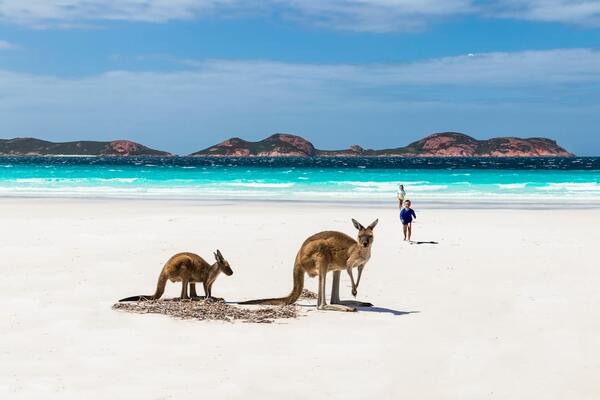Saturday, March 4, 2023

Western Australia’s tourism industry continues to recover from a pandemic-induced slump, but still faces challenges such as realising the potential of cultural tourism, re-engagement with the important Chinese market, and workforce shortages in the region, as per the ‘Go Your Own WA: Recovery and regeneration for the tourism industry in Western Australia’ report, released today by the Bankwest Curtin Economics Centre and the Tourism Research Cluster at Curtin University.
Tourism’s economic contribution to WA decreased to $6.7 billion in 2020-21, 45 percent lower than the high level of $12 billion in 2018-2019. While tourist arrivals and expenditure patterns have improved since borders reopened in March 2022, the research concluded that more work is needed to fully realise the state’s tourism potential.
While total expenditure in WA has grown since borders opened, short-term international visitor arrivals have decreased, according to co-author Dr Daniel Kiely of the Bankwest Curtin Economics Institute.
“Re-engagement with high-expenditure international tourist markets is one key to revitalising the sector in WA. Pre-pandemic figures show China was a top-five source country for overseas visitors, accounting for 6.9 per cent of tourists, but did not feature in the top 10 source countries for short-term arrivals into WA in December 2022,” Dr Kiely said.
“We found global uncertainties and the rate at which international borders have reopened continue to impact the state’s international tourism sector. Analysis of trends in international tourist visits also found it is essential that WA continues to strive to achieve a proportionate share of international students travelling to Australia.”
A critical answer to this challenge has been discovered through unique modelling of data on internet search intensity as a proxy for possible foreign traveller interest in visiting WA.
“The report shows that an increase of 50 per cent in Google search volumes translate to an additional 130,000 visitors and half a billion dollars in extra tourism spending to the state each year,” Dr Kiely said.
“The benefits to the WA economy from marketing Western Australia as a tourism destination are substantial. Campaigns such as the recent Walking on a Dream and the recent video collaboration between Tourism Western Australia and our Eurovision song contest entrant Voyager promote Western Australia as a tourism destination very well.”
According to co-author Associate Professor Michael Volgger of Curtin University’s Tourism Research Cluster, Western Australia has the climate, environmental variety, and pristine natural surroundings with distinct flora and fauna to provide internationally unique tourism experiences.
“WA should capitalise on its unique features to offer distinctive tourist experiences that offer cultural engagement and experiential tourism activities, such as Aboriginal tourism experiences, agritourism or even industrial tourism,” Associate Professor Volgger said.
“Cultural tourism should be supported across all the state’s regional areas, including major regional centres. But for this to be feasible, cultural exchange should be grounded in local cultural customs and practice but should happen alongside a broader agenda to improve the services, economic opportunities, health and living standards of people in remote communities.”
“Traditional owners should be closely involved in the development of Aboriginal tourism in regional areas, with consideration of cultural tourism options and opportunities such as more festivals that deepen visitors’ understanding of the culture, traditions and worldview of local First Nations peoples and affordable tours and walking trails that focus on native flora and fauna, led by Indigenous knowledge holders as guides.”
It was also suggested that Indigenous viewpoints be integrated into science tourism and nature-based tourism, as well as the development of world-class tourist sites, cultural centres, and educational precincts that draw on the state’s distinctive Indigenous culture and history.
The perspectives of regional residents were also measured for the study using a tourism resident survey, which questioned people living in all five regions of Western Australia a series of questions about the impact of tourism on their region.
According to Associate Professor Volgger, the poll highlighted a major issue impacting tourism as the relationship between home affordability and labour shortages.
“Housing affordability is also seen by residents and stakeholders as a key influence impacting labour shortages across the regions. The shortage of staff is in turn impacting visitor experiences and has the potential to damage the WA brand marketed both domestically and abroad,” Dr Volgger said.
“Housing, investment in regional areas and workforce issues need to be addressed as a priority with relevant strategies to ensure a motivated and skilled workforce is available and are attracted to the regions across WA, including access to visas for working holiday makers.”
“The tourism resident survey highlights that residents have a sophisticated perception of tourism, with many identifying both positive and negative impacts of tourism to their regions.”
“Housing prices and rental costs as well as the cost of land and the cost of goods and services were highlighted among the negative impacts from tourism, and unsurprisingly, these were most keenly felt during peak tourism periods,” Associate Professor Volgger said.
But Associate Professor Volgger said many of the same survey respondents recognised a wide range of economic and amenity-related benefits of tourism to their areas.
“Around 83 per cent of residents surveyed in Perth and a similar share of survey respondents in the South West believe that tourism makes an important economic contribution to their region, with nearly three quarters of respondents agreeing that tourism created more jobs,” Associate Professor Volgger said.
Saturday, March 4, 2023
Comments: